The CrystalVue 8X and Kenko 6X are two very popular monoscopes among Nikon Coolpix 950/990/995/4500 users. We have discussed these two lenses as well as Nikon's TC-E2 2X and TC-E3ED 3X on the page of Kenko 6x and CrystalVue Sharp Shooter 8x Monocular Lenses. An interesting question is: Can these two lenses be combined together to have a 48X (6×8) monoscope? If it is possible, what stuffs are needed and how good the quality is? We shall try to answer these questions on this page.
The CrystalVue 8X rear thread size is 37mm, but it comes with a 28-37mm step-up ring to be used with Coolpix 950/990/995/4500. The Kenko 6X has an odd front thread size of 27mm. Since the rear lens element of the Kenko 6X is quite small compared with the front lens element of the CrystalVue 8X, it is unwise to attach the front end of the 8X to the rear end of the 6X. Even though we can make it, vignetting will occur. So, the only reasonable choice is to mount the 8X in front of the 6X. Therefore, we will need a 27-37mm step-up ring or a 27-28 step-up ring. Eventually, I found a 27-28mm step-up ring as shown in the left image below. This step-up ring can easily connect the 8X and 6X together as shown in the right image below. Once this is done, this 6X-8X combo is ready to use on a 950/990/995/4500. With the Nikon's UR-E6 step ring, the combo can be used with Coolpix 5000; however, a slight vignetting occurs in four corners.
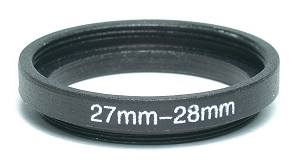
|
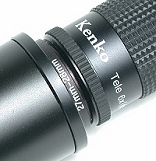
|
|
| 27-28mm step-up ring | ||
Note that a 27-37mm step-up ring does not work properly because its smaller opening (i.e., 27mm) is not large enough to allow the rear element of the 8X lens passing though. This is shown in the image below.
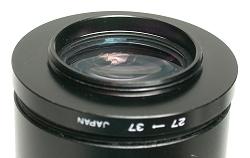
The combo, which is a 48X lens, is quite long as shown below. It is difficult to focus. In my experience, it would be easier to set the Kenko 6X (the rear one) to infinity and only use the 8X (the front one) to focus.
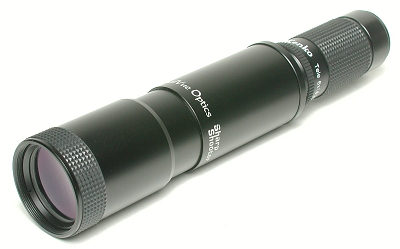
When this combo is mounted on a camera, it can easily become front heavy, making camera movement a big problem. As you can see in the following two images, this combo is quite long on a 4500. The situation with the 5000 is worse because there is an extra tube UR-E6. Due to its length and weight, it is not very easy to hand-hold this combo and the camera.

|

|
|
| 4500 with the 6X-8X Combo | 5000 with the 6X-8X Combo |
The first thing one will notice in using this combo is the difficulty in focusing. This difficulty comes from multiple factors. First, a 48X scope mounted on a 995/4500 (resp., 950/990) has a maximum focal length of 7200mm = 48×150 (resp., 5520mm = 48×115) with a view angle less than 1 degree. Therefore, finding the subject one wants to photograph is extremely difficult. In fact, one may spend most of his time to find the subject! Second, once the subject is found, turning the focusing rings causes a big headache. There are two focusing rings, one on the 8X and the other on the 6X. Turning two rings seems impossible. After trying various ways, I found that it would be convenient if the 6X is set to infinity and only use the 8X for focusing. Now, it comes the third problem: the camera cannot get a lock most of the time unless the lighting condition is extremely good (e.g., under very strong sunlight). Everyone knows that the 6X and 8X cause light loss. My experience shows that each will cause at least 1 EV (or 1 stop) light loss. Therefore, the combo will cause a 2-stop light loss. Since the smallest aperture of the 4500 at the longest focal length is F5.1, the maximum aperture available for the camera to focus is about F10.0. This is, however, too small for an AF camera that uses contrast detection. Consequently, unless the lighting condition is extremely well, a focus lock with this combo is rare. In my experience, I normally find a highlight or very bright spot around the subject, lock on it, and recompose. However, metering could be incorrect because it will use the brighter portion for light measurement. Postprocessing is in general needed because images are likely underexposed.
The following images, shot with a 4500, show the same scene taken with the 6X, 8X and 6X+8X combo. Note that the 6X and 8X images are under-exposed on purpose to retain the details of the garage light, while the 6X + 8X image was over-exposed a little to show the details. It is obvious that the 6X and 8X images do not show much difference; however, the magnification of the 6X+8X is significantly higher than the other two. It is also obvious that the image quality of the 6X+8X is not as high as those of the 6X and 8X. It is softer and contrast is lower. This is understandable. Since the 6X and 8X monoscopes have lower contrast and image quality, the combo will magnify the shortcomings of both, producing an even worse result.
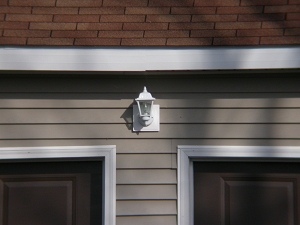
|
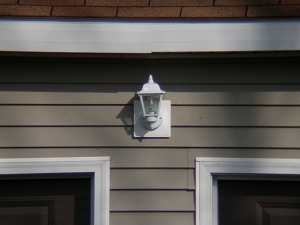
|
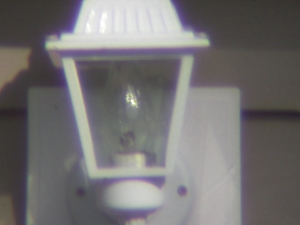
|
| Kenko 6X | CrystalVue 8X | 6X + 8X Combo |
| Click on the image to see a larger one | ||
Let us look at the light more closely. First, we would like to know if a higher magnification image reduced to a smaller size can compete against an image taken with a lower magnification lens. In the images below, the left one is a crop of the 6X image, while the other two are reduced to the size of the first one. As you can see, the reduced 8X image is as good as or even a little sharper than the 6X. Unfortunately, the bluish tone is not welcome. Moreover, chromatic aberration is obvious. The right one inherits the chromatic aberration problem from the 8X, and is not as sharp as the other two. This is understandable because stacking two not-so-sharp lenses won't yield an image sharper than the image taken with either lens. Therefore, even though the 6X+8X is not sharp enough, reducing an image it takes to a smaller size still have reasonable result.

|
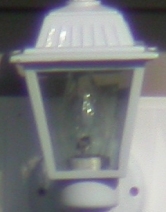
|
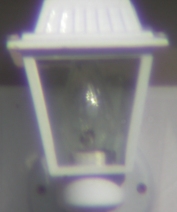
|
| Kenko 6X | CrystalVue 8X | 6X + 8X Combo |
| Click on the image to see the original size | ||
The next three images compare the results of the 6X and 6X+8X against that of the 8X. The 8X image is shown in the middle. The 6X (resp., 6X+8X) one is up-sampled using bicubic interpolation (resp., reduced) to the same size as the 8X. It is obvious that the up-sampled 6X image unavoidably contains artifacts and is worse than the 8X one. The 6X+8X combo image is softer and has a lower contrast than that of the 8X. In general, the 6X+8X combo shares more similarity (i.e., chromatic aberration) with the 8X than with the 6X.
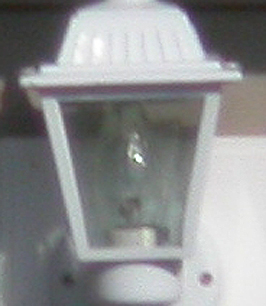
|

|
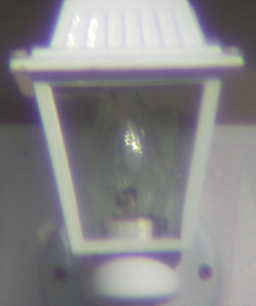
|
| Kenko 6X | CrystalVue 8X | 6X + 8X Combo |
| Click on the image to see the original size | ||
Finally, we shall take a look at the possibility of scaling an image up to match the 48X magnification. This is similar to digital zoom, except that the up-sampling is done with the bicubic interpolation feature of Photoshop 7.0. Since the images are very large, I choose to only blow up the base portion of the garage light. The following shows the results. The up-sampled images still look sharper and have higher contrast than the 6X+8X one. Since the up-sampling of the 8X is not as high as the 6X, it is the sharpest. However, the obvious artifacts make both up-sampled images, especially the 6X one, not acceptable. The 6X+8X image, although looks soft with lower contrast, looks smoother.
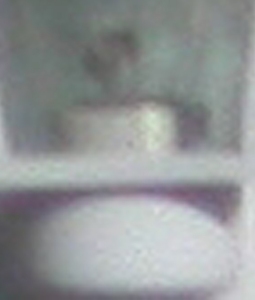
|
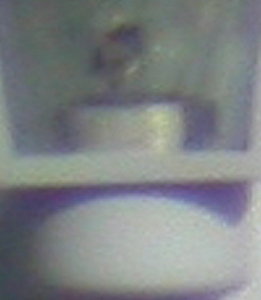
|
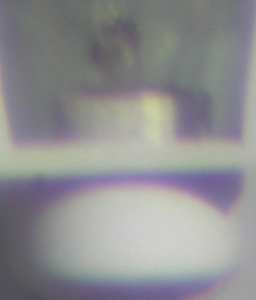
|
| Kenko 6X | CrystalVue 8X | 6X + 8X Combo |
| Click on the image to see the original size | ||
The following shows three sets of images. The images on the same column were taken with a 4500 at its maximum focal length of 152mm, 6X, 8X and 6X+8X combo. A blue rectangle is shown in a 8X image to indicate the area covered by the 6X+8X combo. All images are not edited to show the performance of the lenses and the combo. The only editing operations done were resizing and nominal sharpening (after resizing, of course).
| |
Click on the image to see a larger one | ||
| 4500 |

|

|

|
| 6X |

|
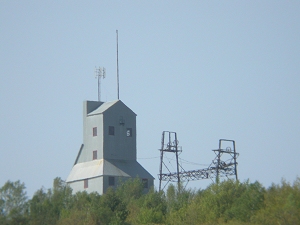
|

|
| 8X |
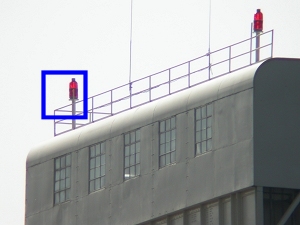
|
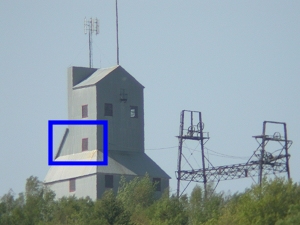
|

|
| 6X+8X |
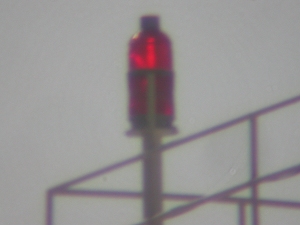
|
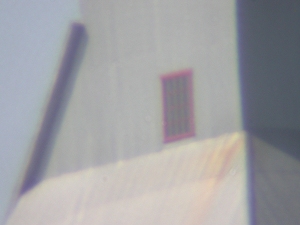
|
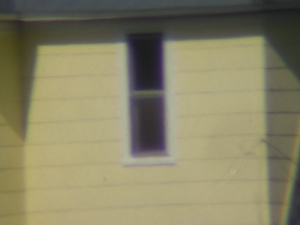
|
| |
Click on the image to see a larger one | ||
This test was initiated by my curiosity to see how good a 6X+8X combo is compared against my other scopes. The difficulty in focusing appeared at the very beginning, and this is the reason that there are not very many images on this page. In general, I am disappointed with this combo. Unless I am extremely lucky and the scene is very bright, I cannot make my 4500 locking on the subject being photographed. Moreover, the images I got are soft and low contrast. Hence, my conclusions are: (1) You certainly can try this combo out; however, unless you will eventually reduce the image size, the 6X+8X combo may not satisfy you. (2) The image quality of the 8X plus 4X digital zoom gives a 32X magnification. Although it is not as high as the 6X+8X combo and may have unwanted artifacts, the results may still be sharper with higher contrast. Of course, one can always use an editing program to remove most of the extra artifacts. But, playing a 48X scope is certainly an interesting (and demanding) event.
While the 6X+8X combo does not provide me with good results, the 27-28mm step-ring does offer so many ways of increasing magnification. For example, one can mount a Nikon TC-E2 or TC-E3ED on a 6x to get 12X and 18X magnifications, respectively, as shown below:
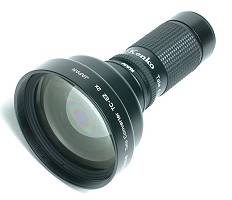
|

|
| 6X + TC-E2 (12X) | 6X + TC-E3ED (18X) |
Or, we may use other teleconverters such as Olympus B300 1.7X, Olympus TCON-17 1.7X, or Sony VCL-HGD1758 1.7X. Of course, step-rings will be needed.
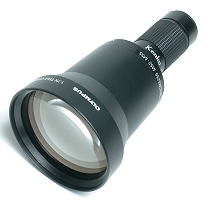
|
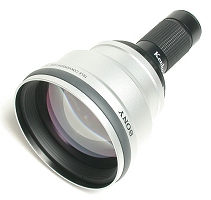
|
| 6X + Olympus TCON-17 (10.2X) | 6X + Sony 1.7X (10.2X) |
Once we have high quality converters, there is no reason we cannot stack them together to yield even higher magnification lenses. The following shows various possibilities of stack TC-E2, TC-E3ED, Olympus TCON-17 and Sony 1.7X together.

|
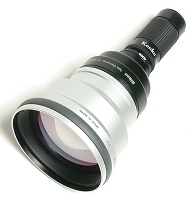
|
| 6X + TC-E2 + TCON-17 (20.4X) | 6X + TC-E2 + Sony 1.7X (20.4X) |
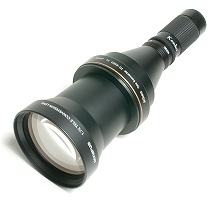
|
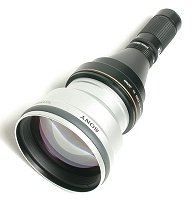
|
| 6X + TC-E3ED + TCON-17 (30.6X) | 6X + TC-E3ED + Sony 1.7X (30.6X) |
We shall see how these combos perform in the near future.